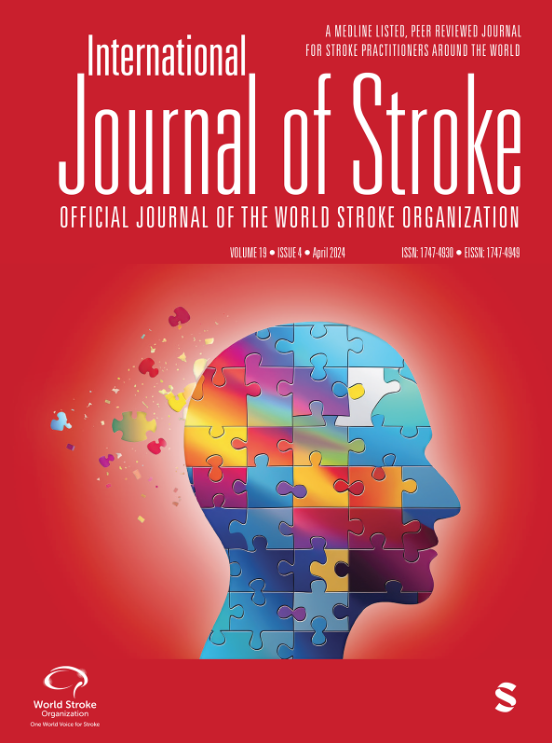AHA/ASA 和 DSM-V 的血管性认知障碍诊断标准确定了以血管病变为主的病例。
IF 6.3
2区 医学
Q1 CLINICAL NEUROLOGY
引用次数: 0
摘要
背景:在临床上确定血管性认知障碍(VCI)的病因存在重大挑战,尤其是在存在血管性和淀粉样蛋白等混合病理的情况下。最近,有两个标准(美国心脏协会/美国卒中协会[AHA/ASA]和《精神疾病诊断与统计手册》第五版[DSM-V])被提出用于血管性认知障碍的临床诊断,但尚未通过神经影像学进行验证。研究目的:本研究旨在确定 AHA/ASA 和 DSM-V 的 VCI 标准能否区分以血管病变为主的病例和混合病变的病例。所有受试者均接受了临床和神经心理学评估、核磁共振成像和[11C] PiB PET 扫描。根据 AHA/ASA 和 DSM-V 标准对 VCI 的病因亚型[可能的血管性轻度认知障碍(VaMCI)、可能的 VaMCI、非 VaMCI、可能的血管性痴呆(VaD)、可能的 VaD、非 VaD]进行了诊断。结果:使用κ统计,两种标准对可能的血管性痴呆(VaMCI)、可能的血管性痴呆(VaD)和可能的血管性痴呆(VaD)的一致性极佳(κ=1.00),对可能的血管性痴呆(VaMCI)的一致性良好(κ=0.71)。根据 AHA/ASA 标准,可能 VaMCI(3.8%)和可能 VaD(15%)的淀粉样蛋白阳性率明显低于可能 VaMCI(26.7%)、非 VaMCI(33.3%)、可能 VaD(73.3%)和非 VaD(76.2%)(p<0.001)。同样,使用 DSM-V 标准,可能 VaMCI(3.8%)和可能 VaD(15%)的淀粉样蛋白阳性率显著低于可能 VaMCI(26.3%)、非 VaMCI(32.1%)、可能 VaD(73.3%)和非 VaD(76.2%)(p<0.001)。两种标准在区分非 VaD 和可能 VaD 患者与可能 VaMCI 和可能 VaD 患者方面具有良好的一致性,前者的总体[11C]-PiB SUVR 明显更高(p<0.001),而后者则以血管病变为主。结论:AHA/ASA和DSM-V的VCI标准可以识别几乎没有淀粉样病变的VCI病例,因此支持AHA/ASA和DSM-V标准在诊断以血管病变为主的患者时的实用性。本文章由计算机程序翻译,如有差异,请以英文原文为准。
The AHA/ASA & DSM-V diagnostic criteria for vascular cognitive impairment identify cases with predominant vascular pathology.
BACKGROUND:There are major challenges in determining the aetiology of vascular cognitive impairment (VCI) clinically, especially in the presence of mixed pathologies, such as vascular and amyloid. Most recently, two criteria (American Heart Association/American Stroke Association [AHA/ASA] and Diagnostic and Statistical Manual of Mental Disorders, Fifth Edition [DSM-V]) have been proposed for the clinical diagnosis of VCI but have not as yet been validated using neuroimaging.AIMS:This study aims to determine whether the AHA/ASA and DSM-V criteria for VCI can distinguish between cases with predominantly vascular pathology and cases with mixed pathology.METHODS:186 subjects were recruited from a cross-sectional memory clinic-based study at the National University Hospital, Singapore. All subjects underwent clinical and neuropsychological assessment, MRI and [11C] PiB PET scans. Diagnosis of the etiological subtypes of VCI [probable vascular mild cognitive impairment (VaMCI), possible VaMCI, non-VaMCI, probable vascular dementia (VaD), possible VaD, non-VaD] were performed following AHA/ASA and DSM-V criteria. Brain amyloid burden was determined for each subject with standardised uptake value ratio (SUVR) values ≥ 1.5 classified as amyloid positive.RESULTS:Using κ statistics, both criteria had excellent agreement for probable VaMCI, probable VaD, and possible VaD (κ=1.00), and good for possible VaMCI (κ=0.71). Using the AHA/ASA criteria, the amyloid positivity of probable VaMCI (3.8%) and probable VaD (15%) was significantly lower compared to possible VaMCI (26.7%), non-VaMCI (33.3%), possible VaD (73.3%) and non-VaD (76.2%) )(p<0.001). Similarly, using the DSM-V criteria the amyloid positivity of probable VaMCI (3.8%) and probable VaD (15%) were significantly lower compared to possible VaMCI (26.3%), non-VaMCI (32.1%), possible VaD (73.3%) and non-VaD (76.2%)(p<0.001). In both criteria, there was good agreement in differentiating individuals with non-VaD and possible VaD, with significantly higher (p<0.001) global [11C]-PiB SUVR, from individuals with probable VaMCI and probable VaD, who had predominant vascular pathology.CONCLUSIONS:The AHA/ASA and DSM-V criteria for VCI can identify VCI cases with little to no concomitant amyloid pathology, hence supporting the utility of AHA/ASA and DSM-V criteria in diagnosing patients with predominant vascular pathology.
求助全文
通过发布文献求助,成功后即可免费获取论文全文。
去求助
来源期刊

International Journal of Stroke
医学-外周血管病
CiteScore
13.90
自引率
6.00%
发文量
132
审稿时长
6-12 weeks
期刊介绍:
The International Journal of Stroke is a welcome addition to the international stroke journal landscape in that it concentrates on the clinical aspects of stroke with basic science contributions in areas of clinical interest. Reviews of current topics are broadly based to encompass not only recent advances of global interest but also those which may be more important in certain regions and the journal regularly features items of news interest from all parts of the world. To facilitate the international nature of the journal, our Associate Editors from Europe, Asia, North America and South America coordinate segments of the journal.
 求助内容:
求助内容: 应助结果提醒方式:
应助结果提醒方式:


